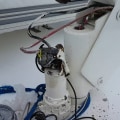Lifeboat maintenance is a critical part of ensuring the safety of seafaring vessels and their passengers. While lifeboats help protect people in the event of an emergency, they must be regularly maintained to ensure they remain in optimal condition. While performing maintenance on a lifeboat, it is important to take extra precautions to ensure the safe handling of hazardous materials. It is essential to understand the potential risks associated with hazardous materials and the best practices for safely handling them during lifeboat maintenance. This article will provide an overview of how to safely handle hazardous materials during lifeboat maintenance and why following safety protocols is essential.
Hazardous Materials
encountered during lifeboat maintenance can include fuels, lubricants, solvents, and other chemicals.These materials can pose a variety of risks if not handled properly, and following safety protocols is essential to ensure the safety of personnel. It is important to recognize the potential hazards associated with handling hazardous materials and take the necessary steps to protect oneself and others. When dealing with hazardous materials, it is important to wear the appropriate personal protective equipment (PPE) such as gloves, eye protection, and respirators. Additionally, it is important to read the product labels and Material Safety Data Sheets (MSDS) to understand the potential risks of exposure. Proper ventilation should be provided when working with these materials, and workers should be trained in proper safety procedures.
Safe Handling Practices
are essential when dealing with hazardous materials.Workers should avoid skin contact with these materials and be aware of any potential spills or leaks. All spills should be cleaned up immediately using the appropriate absorbent material. Disposable gloves should be worn when handling any hazardous material, and any clothing contaminated with these materials should be removed immediately. It is also important to ensure that all containers are tightly sealed and labeled correctly.
Proper Storage
is also an important consideration when dealing with hazardous materials.Containers should be stored in a secure area away from flammable sources and out of direct sunlight. Containers should also be labeled clearly with the type of material they contain and the date it was stored. Any containers that appear to be leaking or damaged should not be used and disposed of immediately.
Identifying Hazardous Materials
is essential when performing maintenance on a lifeboat. Material Safety Data Sheets (MSDS) provide information on the type of material, its potential hazards, and how to handle it safely.Additionally, there may be warning signs or labels on the container that indicate that the material is hazardous. It is important to be aware of these signs and labels so that proper safety protocols can be followed.
Disposal
of hazardous materials must also be done safely and correctly. Depending on the type of material, it may need to be taken to a hazardous waste facility or properly disposed of in accordance with local laws. It is important to research local laws and regulations regarding the disposal of hazardous materials in order to ensure that all safety protocols are followed.Safety Protocols for Handling Hazardous Materials
When performing maintenance on a lifeboat, it is essential to handle hazardous materials correctly and safely.There are a number of safety protocols and procedures that must be followed when dealing with hazardous materials during lifeboat maintenance. The first step in any hazardous material handling situation is to use appropriate protective equipment. This includes wearing gloves, protective eyewear, and a respirator when necessary. Additionally, it is important to follow all safety procedures outlined by the manufacturer or other relevant authorities.
When storing and disposing of hazardous materials, it is important to ensure that containers are properly labeled and stored in a safe location. Additionally, any waste generated must be disposed of in an appropriate manner according to local regulations. In summary, when performing maintenance on a lifeboat it is essential to follow safety protocols when handling hazardous materials. This includes using protective equipment, following safety procedures, and properly storing and disposing of hazardous materials. In conclusion, it is essential to adhere to the correct safety protocols when handling hazardous materials during lifeboat maintenance.
Implementing proper safety protocols can help reduce the risks associated with exposure to these materials and ensure that they are stored and disposed of correctly. Following these guidelines can help keep both people and the environment safe.


